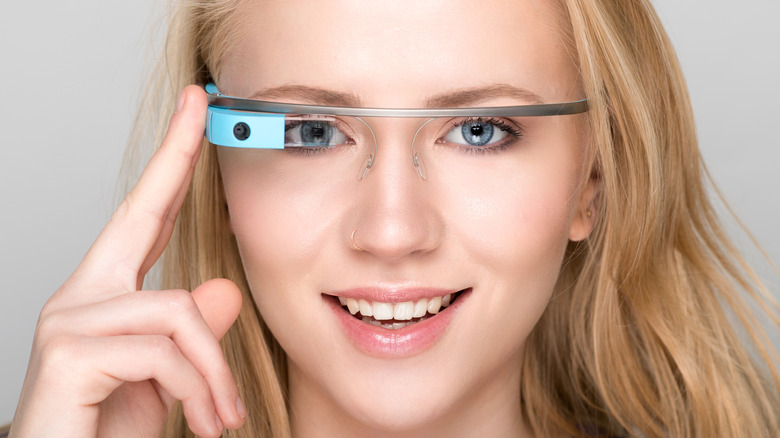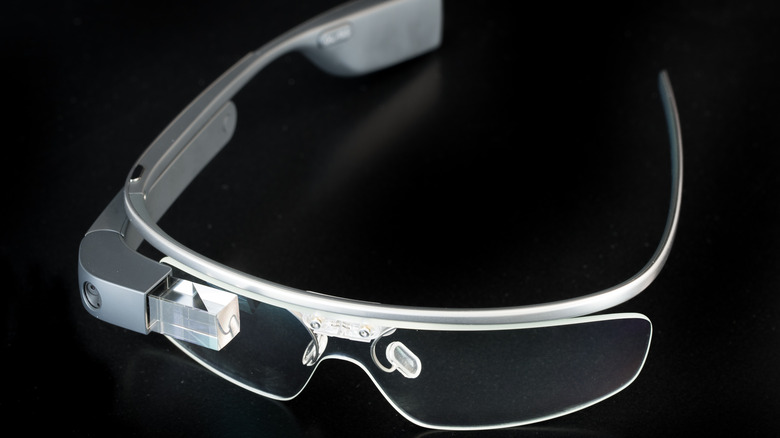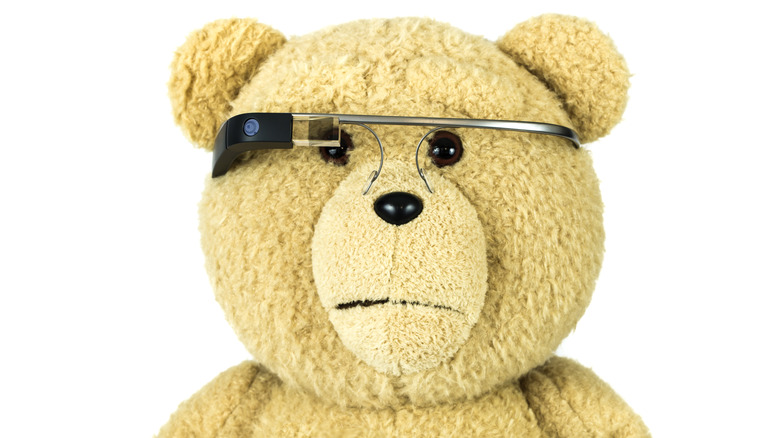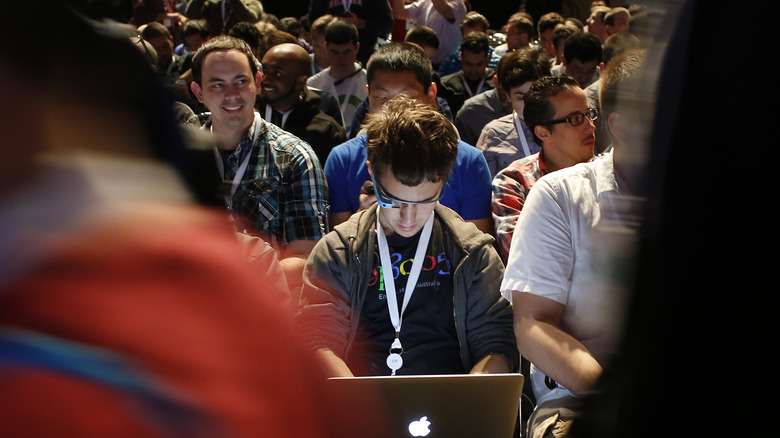The Fascinating True Story Behind The Failure Of Google Glass
Google Glass was supposed to be a game-changer when it was unveiled in 2013. It featured a hidden camera, speakers, microphone, central processing unit, Bluetooth, and Wi-Fi connectivity. You could use Google Glass to see your upcoming events like scheduled flights and lunch dates — or even nearby places to eat. You could swap right to see what your friends were up to if they updated their status or shared photos. Of course, you could answer video or audio calls using voice or motion recognition as well.
It was one of the hottest gadgets coming out of Silicon Valley, and you needed an invitation to get your hands on it. However, Google made it available to the public a few months after it was unveiled. Then one day, when the hype fizzled out, Google announced it was discontinuing the prototype. Like a thief in the night, it just vamoosed never to be seen again. What exactly happened that caused Google to abandon its revolutionary glasses?
The prototype was not ready
According to The New York Times, the Google Glass prototype was not supposed to be released to the general public. In fact, when Google started working on the project, it was shrouded in so much secrecy that most Google employees didn't know anything about it. Behind the scenes, the engineers were not sure if the glasses should be an everyday accessory, or one of those things you wear occasionally. But Sergey Brin, the co-founder of Google, had other ideas — the intention was to let the cat out of the bag and receive feedback from the public. The problem was that the engineers at Google thought there was a lot of work to be done before Google Glass would be ready.
Google proceeded with the plan and introduced the Explorer Program to test out Google Glass — but you needed $1,500 to access it. However, it didn't take long for some reviewers who tried it to admit that they were disappointed (via Insider). Besides that, most people complained of headaches and eyestrain if they wore Google Glass for too long. Google didn't even bother to include a health warning for users — according to CNET. The prototype was only designed to be used for micro-interactions — it wasn't meant for watching movies, reading books, or working on your laptop.
Google Glass' privacy concerns
The elephant in the room when most people tried Google Glass was privacy concerns. As soon as word got out about Google Glass, it was banned in casinos, hospitals, sports arenas, movie theaters, college classrooms, and restaurants (via Forbes). Also, it was not unusual for people to get confronted or denied access to public spaces if they were spotted wearing Google Glass. There was even a nickname for people who wore it — "glassholes."
At least 72% of Americans were concerned about their privacy upon the public release of Google Glass — according to Adweek. Of course, it didn't help that most people couldn't tell when they were being recorded by the Google Glass camera. This is because it didn't display a flashing LED light when the camera was recording, and the only way you could know was if you were in close proximity to a Google Glass wearer (via CNET).
Google's project was clouded by a scandal
Like a script from a soap opera drama, a secret love affair could have contributed to the failure of Google Glass. Google's co-founder, Sergey Brin, had an affair with employee Amanda Rosenberg. Back then, Rosenberg was one of the people who worked behind the scenes — alongside renowned Belgian fashion designer Diane von Fürstenberg — to promote Google Glass at New York Fashion Week. She was also the marketing manager of Google Glass, and occasionally modeled to advertise the product. Soon after the affair was uncovered, Brin split up with his wife, and Rosenberg was transferred to a different department in 2013 — according to The New York Post.
Interestingly, after the scandal blew up and Rosenberg was transferred, Google's marketing for Glass dwindled and fewer employees at the tech company were spotted wearing the glasses (via Insider). Brin was later replaced by Ivy Ross as the head of Google Glass one year after the affair became public.
The writing was on the wall, and by January 2015, Google discontinued its smart Glasses program — four years after the first prototype was produced in Google's X lab.
The Google Glass Enterprise Edition lives on
Even though the Google Glass obituary was written in 2015, the story is not yet complete. After it was taken off the market, a new team went back to resuscitate it. Having learned from its mistakes, the guys in charge of reviving the project confirmed that it could be a while before the glasses are released to the general public again. However, Google Glass is still used by factory workers to increase production and train new employees. More succinctly, Google Glass can scan a piece of equipment to help factory workers access manuals, photos, or videos on the spot — this saves time since you don't need to constantly check your computer. At the moment, Google Glass Enterprise Edition is mostly limited to businesses that specialize in manufacturing, logistics, and field services.
Google Glass is also used by autistic children to make it easier to read people's facial expressions. According to the clinical trials, Google Glass paired with an app to recognize people's emotions through facial expressions can reduce severe autism symptoms in children.
Google is now focusing on its AR Glasses
With the Google Glass Enterprise Edition limited to factory workers, trainers, and technicians, Google currently doesn't have a similar product for the general public. But things could change with its upcoming AR Glasses, which could be the spiritual successor to Google Glass. Having learned from Google Glass' failure, its upcoming smart glasses don't capture video or photos for users because of privacy concerns.
Instead, Google's AR Glasses will be used to break down language barriers: If someone is talking to you in a foreign language, it will transcribe the audio and relay the translated subtitles to the glasses in real time. It can also translate sign language — and if you're deaf, it could also be helpful to understand people who don't know sign language. Unlike Google Glass, the AR prototypes come with LED indicators that will let other people know when the camera is recording. The information recorded by the AR Glasses when it's translating will be stored on Google's secure servers and automatically deleted after 30 days. However, Google says that it won't upload any data with private information such as license plates, faces, and signs to its servers.
Google's AR Glasses are currently in the beta phase, and the tech company has not revealed if and when they would be available for the public.




